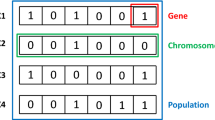Abstract
This paper illustrates the application of a new model combined Genetic Algorithm with Heuristic Programming (GA-HP) technique in order to establish the optimal design for sewer networks. The objective is to minimise the construction cost function, which is represented by the depth of excavation and pipe diameter. The proposed GA-HP model has achieved the optimum design task in two stages. Firstly, the Genetic Algorithm (GA) was applied to obtain the diameters of the pipes needed for the preliminary design of the network. Secondly, Heuristic Programming (HP) preliminary designs were used to obtain the optimal slope for those pipes and to determine other characteristics such as the velocity, relative depth of water, excavation depths and total cost of the network. A MATLAB code was used to perform the GA-HP optimisation modelling. The performance of three different selection methods, four different crossover methods and different population sizes is examined with the proposed model, to determine their impact on convergence behaviour. The proposed GA-HP model is tested using some benchmark examples of sewer networks from the literature. The results show that the GA-HP model is superior to all previous methods and may be more efficient in the design of large networks.






Similar content being viewed by others
References
Afshar MH (2006) Improving the efficiency of ant algorithms using adaptive refinement: application to storm water network design. Adv Water Resour 29(9):1371–1382
Afshar MH (2012) Rebirthing genetic algorithm for storm sewer network design. Scientia Iranica 19(1):11–19
Afshar MH, Afshar A, Marino MA, Darbandi AAS (2006) Hydrograph-based storm sewer design optimization by genetic algorithm. Can J Civ Eng 33(3):319–325
Cisty M (2010) Hybrid genetic algorithm and linear programming method for least-cost Design of Water Distribution Systems. Water Resour Manag 24(1):1–24
Dajani J, Hasit Y (1974) Capital cost minimization of drainage networks. J Comput Civ Eng 100(2):325–337
Deininger RA (1966) Computer aided design of waste collection and treatment systems. In: Proc. 2nd annual conference of American water resources, Chicago
Gidley J (1986) Optimal design of sanitary sewers. In: Proc. 4th ASCE conference on computing in civil engineering, Boston
Guo Y, Walters G, Savic D (2008) Optimal design of storm sewer networks: past, present and future. In: Proc. 11th international conference on urban drainage, Edinburgh
Holland ME (1966) Computer models of waste-water collection systems. PhD Thesis, Harvard University
Karovic O, Mays LW (2014) Sewer system design using simulated annealing in excel. Water Resour Manag 28(13):4551–4565
Lemieux PF, Zech Y, Delarue R (1976) Design of a stormwater sewer by nonlinear programming—1. Can J Civ Eng 3(1):83–89
Liang LY, Thompson RG, Young DM (2004) Optimising the design of sewer networks using genetic algorithms and Tabu search. Eng Constr Archit Manag 11(2):101–112
Mansouri M, Khanjani M (1999) Optimization of sewer networks using nonlinear programming. J Water Wastewater 10(2):20–30
Mays LW, Wenzel HG (1976) Optimal design of multilevel branching sewer systems. Water Resour Res 12(5):913–917
Mays LW, Yen BC (1975) Optimal cost design of branched sewer systems. Water Resour Res 11(1):37–47
Meredith D (1972) Dynamic programming with case study on planning and design of urban water facilities. Treatise Urban Water Syst:37–47
Merritt LB, Bogan RH (1973) Computer-based optimal design of sewer systems. J Environ Eng Div 99(1):35–53
Michael GC (1972) A review of heuristic programming. Decis Sci 3:74–100
Miles S, Heaney J (1988) Better than “optimal” method for designing drainage systems. J Water Resour Plan Manag 114(5):477–499
Nzewi EU, Gray DD, Houck MH (1985) Optimal design program for gravity sanitary sewers. Civ Eng Syst 2(3):132–141
Ostadrahimi L, Marino MA, Afshar A (2012) Multi-reservoir operation rules: multi-swarm PSO-based optimization approach. Water Resour Manag 26(2):407–427
Pan T-C, Kao J-J (2009) GA-QP model to optimize sewer system design. J Environ Eng Div 135(1):17–24
Reca J, Martinez J, Gil C, Banos R (2008) Application of several meta-heuristic techniques to the optimization of real looped water distribution networks. Water Resour Manag 22(10):1367–1379
Robinson DK, Labadie JW (1981) Optimal design of urban storm water drainage systems. Inernational. Symposium on Urban Hydrology, Hydraulics, and Sediment Control. University of Kentucky, Lexington
Rohani M, Afshar M (2012) Optimal design of sewer networks using cellular automata-based hybrid methods: discrete and continuous approaches. Eng Optim 44(1):1–22
Rohani M, Afshar MH (2014) GA–GHCA model for the optimal design of pumped sewer networks. Can J Civ Eng 42(1):1–12
Shahidi M, Rohani M, Afshar M, Sargolzaei M (2011) Application of cellular automata to sewer network optimization problems. Scientia Iranica 18(3):304–312
Sotoodeh M (2004) Optimal design of sewer networks. Mcs. Thesis, University of Science and Technology
Sotoodeh MH, Afshar MH (2003) Optimal design of sewer networks using mathematical programming and genetic algorithm methods. In: Proceedings of Second National Congress on Civil Engineering. University of Tehran, Tehran
Swamee PK, Sharma AK (2013) Optimal design of a sewer line using linear programming. Appl Math Model 37(6):4430–4439
Tang WH, Mays LW, Yen BC (1975) Optimal risk based design of storm sewer networks. J Environ Eng Div ASCE 101(3):381–398
Yeh S-F, Chu C-W, Chang Y-J, Lin M-D (2011) Applying Tabu search and simulated annealing to the optimal design of sewer networks. Eng Optim 43(2):159–174
Yeh SF, Chang YJ, Lin MD (2013) Optimal design of sewer network by Tabu search and simulated annealing. Industrial Engineering and Engineering Management (IEEM), 2013 I.E. International Conference on, 10–13 Dec. 2013, pp 1636–1640
Yen BC (2001) Hydraulics of sewer systems. Stormwater Collection Systems Design Handbook. McGraw-Hill, New York
Zaheri MM, Afshar MH (2016) A two phase simulation-optimization cellular automata method for sewer network design optimization. Applied Soft Computing, under publishing
Zaheri M, Afshar M, Kim J (2016) Improving the efficiency of cellular automata for sewer network design optimization problems using adaptive refinement. Proc Eng 154:1439–1447
Author information
Authors and Affiliations
Corresponding author
Rights and permissions
About this article
Cite this article
Hassan, W.H., Jassem, M.H. & Mohammed, S.S. A GA-HP Model for the Optimal Design of Sewer Networks. Water Resour Manage 32, 865–879 (2018). https://doi.org/10.1007/s11269-017-1843-y
Received:
Accepted:
Published:
Issue Date:
DOI: https://doi.org/10.1007/s11269-017-1843-y




